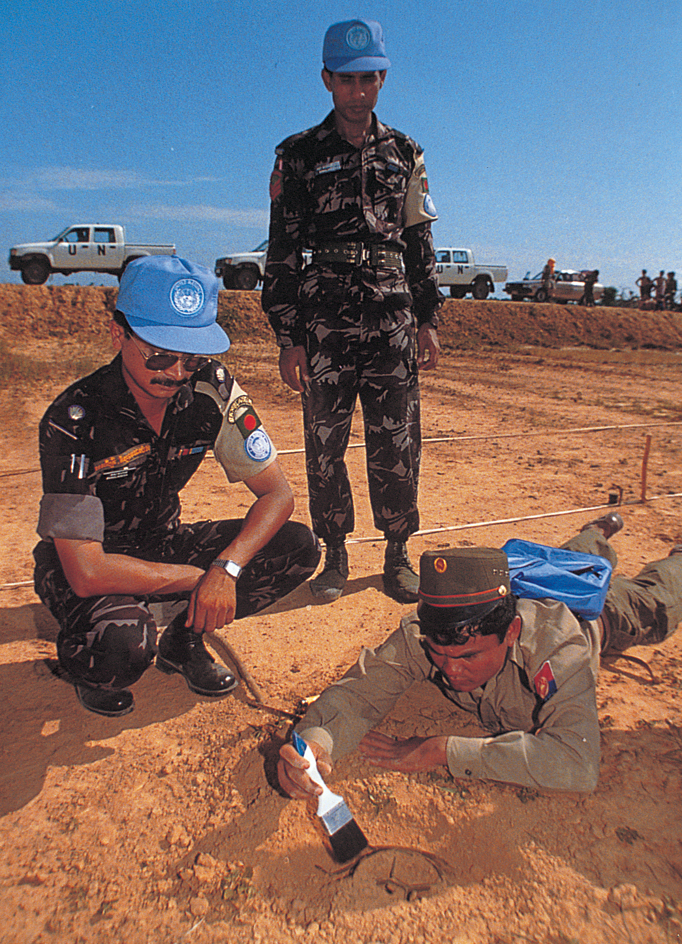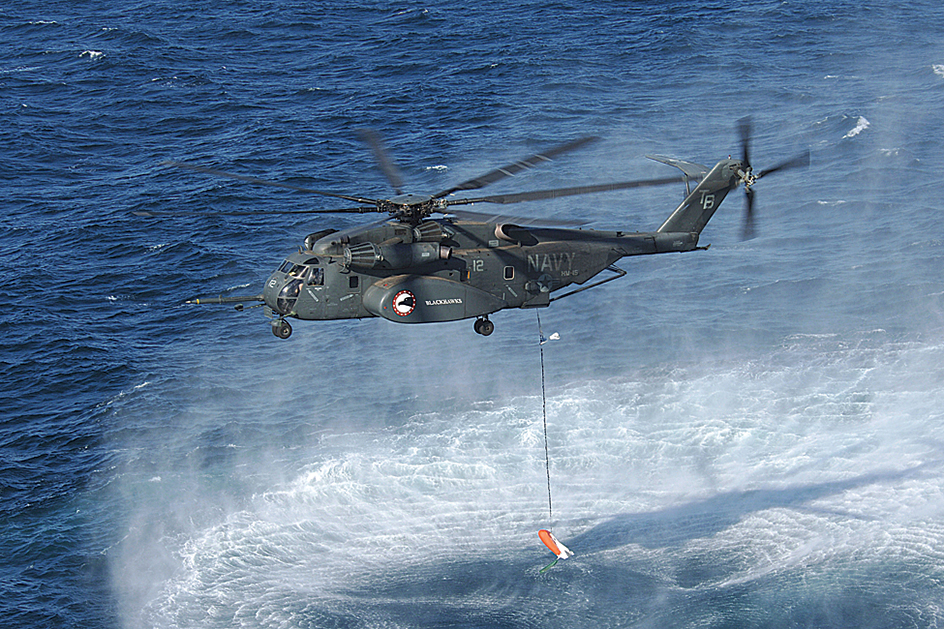Mine warfare is the strategic placement of explosive devices called mines that can kill enemy troops and destroy ships, tanks, and other equipment. Some mines explode when a person steps on them. Others explode when run over by a tank or jeep. Naval mines are detonated (exploded) by the effects produced by a passing ship. Mines also may be exploded by remote control.
Mines can be positioned to prevent an enemy from entering an area. They can also be used to influence the course traveled by enemy troops or ships. By avoiding mined areas, enemy forces may be forced to take routes where they can be attacked more easily.
Mines are inexpensive compared to many other weapons, and persons with little training can put them into place. But the use of mines has become controversial because they are often left behind after a conflict and can injure or kill unintended victims.
There are two chief kinds of mines. They are land mines and naval mines.
Land mines
Land mines are planted in the ground. They may be laid out in planned patterns called minefields. Mines may be planted by soldiers or fired into an area by artillery. They also may be dropped by helicopters.
Kinds of land mines.
There are three main types of land mines. They are (1) antipersonnel mines, (2) antitank mines, and (3) controlled mines.
Antipersonnel mines
are used to kill or injure enemy soldiers. They have a sensitive fuse (triggering device) that is set off by the weight of even a small person. They also may be set off when someone walks into a wire or moves an object to which the mines are wired.
Some antipersonnel mines have small explosive charges and kill only a few persons a short distance away. Others can kill many people more than 200 yards (180 meters) away. Some antipersonnel mines fire an explosive charge that explodes in the air, spraying shrapnel over a large area (see Shrapnel ).
Mines called booby traps explode when they are moved. They are hidden in buildings; under dead soldiers; or in ordinary objects, such as appliances and briefcases, that are likely to be moved by enemy troops. Antipersonnel mines called smart mines are designed to either self-destruct or stop functioning after a set period. Troops use smart mines to prevent accidental deaths or injuries that mines can cause after fighting ends.

Antitank mines
destroy enemy tanks and other vehicles. These mines are larger than antipersonnel mines. Most types of antitank mines explode only when a weight of more than about 300 pounds (140 kilograms) moves over them. Soldiers can walk safely on antitank mines. But these mines destroy trucks and lightly armored vehicles and at least damage the metal tracks on which tanks move.

Controlled mines
are placed in position before a battle. They are exploded by remote control when enemy forces approach the mines.
Detecting land mines.
Land mines can be detected by several methods. Soldiers may locate mines by crawling along the ground and carefully probing the area ahead with their bayonets. When a mine is found, it is cautiously dug out and the fuse is removed, or its position is marked so it can be bypassed. Sensitive instruments called mine detectors can locate mines, as can specially trained animals, such as dogs. Mines can be detected more rapidly by a device mounted on a jeep that causes the jeep to stop when it detects a mine.
After mines have been detected, they may be marked and bypassed or exploded. Specially trained and equipped personnel can safely explode mines, sometimes using devices called snakes. Snakes are long tubes packed with explosives that are detonated in a mined area. The blast sets off nearby mines and clears a path for troops and vehicles. Tanks fitted with special rollers or chain devices can also safely detonate mines. Untriggered smart mines sometimes fail to self-destruct or to stop functioning. For this reason, soldiers treat them as “live” mines when clearing mine fields.
Efforts to ban land mines.
Every year, thousands of people are killed or maimed by antipersonnel land mines. The vast majority are civilians who come into contact with mines planted years ago and left behind long after the fighting stopped. In the early 1990’s, several organizations began calling for a global ban on antipersonnel land mines. One such organization, the International Campaign to Ban Land Mines, won the Nobel Peace Prize in 1997 for its efforts. In December 1997, an international treaty was introduced calling for a worldwide ban on antipersonnel mines. In March 1999, the treaty went into force. At that time, more than 130 countries had signed the treaty and 65 had ratified (approved) it. Nearly 100 more countries later ratified the treaty. But other countries, including the United States and Russia, consider the mines an important defensive weapon and have refused to sign the treaty.

Naval mines
Naval mines rest on or are anchored to the floor of a body of water. Some naval mines float freely, but such mines are dangerous to friendly ships as well as enemy vessels. Naval mines are laid by surface ships, including vessels called minelayers, and by aircraft and submarines. Some naval mines are self-propelled. They are launched from a submarine and travel a few miles before settling on the ocean floor. The CAPTOR mine of the United States Navy is anchored to the ocean bottom. The mine launches a self-guided torpedo after detecting the propeller noise of a passing submarine.
Kinds of naval mines.
There are four chief kinds of naval mines. They are (1) acoustic mines, (2) contact mines, (3) magnetic mines, and (4) pressure mines.
Acoustic mines
are exploded by the sound of a ship’s propellers.
Contact mines
are triggered when a ship touches them. They also may be exploded when a ship touches antennas that stick out from the mines.
Magnetic mines
are triggered by the magnetic field that surrounds a metal warship. To avoid setting off a magnetic mine, a ship may use a set of electrical cables called a degaussing belt, which reduces or neutralizes the magnetic field.
Pressure mines
explode when passing ships cause a change in the water pressure around the mines.
Detecting naval mines.
Naval mines are difficult to detect and to sweep (remove or detonate). They may be fitted with counting devices that allow a certain number of ships to pass before the mines explode. The mines may also be fitted with timers that prevent them from firing for a certain number of hours or days. Ships called minesweepers use sonar to locate mines, which are then swept. Minesweeping helicopters tow devices that sweep mines in shallow water. Ships called minehunters operate cable-controlled vehicles that examine and destroy mines on the ocean floor.

Acoustic mines are blown up by noisemaking devices towed underwater. The anchor cables of contact mines are cut by instruments towed underwater by minesweepers. The mines then float to the surface and are exploded by gunfire. Some magnetic mines are triggered by electrical devices towed by ships. Pressure mines are cleared by having a small, specially equipped ship pass nearby to detonate them.
History
Land mines have been used in warfare for more than 200 years. The term mine came from the practice of digging tunnels under enemy positions, packing the tunnels with gunpowder, and exploding them. During the American Civil War (1861-1865), Union soldiers mined a section of Confederate trenches at Petersburg, Virginia. The soldiers dug a tunnel more than 500 feet (150 meters) long, placed gunpowder in it, and blew a large crater in the Confederate defenses. During World War I (1914-1918), troops buried artillery shells that exploded when stepped on by a person or run over by a tank or truck. After World War I, mines with wood, metal, or plastic containers were developed. Mass-produced land mines were widely used during World War II (1939-1945) and later wars.
The first naval mines—floating vessels that contained explosives—were used in the late 1500’s. Early types of underwater mines, called torpedoes, were sealed wood containers filled with gunpowder and equipped with a fuse. The fuse was set, and a diver swam under an enemy ship and attached the torpedo to the ship’s hull. During the Revolutionary War in America (1775-1783), David Bushnell, an American inventor, developed the first American submarine equipped with a mine-attaching device. During the Civil War, both the Confederate and Union navies used underwater mines. Naval mines were also used extensively in most later wars.
